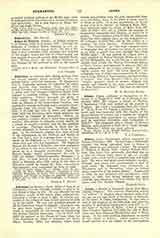

Adamites, an obscure sect, dating perhaps from the second century, which professed to have regained Adam‘s primeval innocence. St. Epiphanius and St. Augustine mention the Adamites by name, and describe their practices. They called their church Paradise; they condemned marriage as foreign to Eden, and they stripped themselves naked while engaged in common worship. They could not have been numerous. Various accounts are given of their origin. Some have thought them to have been an offshoot of the Carpocratian Gnostics, who professed a sensual mysticism and a complete emancipation from the moral law. Theodoret (Haer. Fab., I, 6) held this view of them, and identified them with the licentious sects whose practices are described by Clement of Alexandria. Others, on the contrary, consider them to have been misguided ascetics, who strove to extirpate carnal desires by a return to simpler manners, and by the abolition of marriage. Practices similar to those just described appeared in Europe several times in later ages. In the thirteenth century they were revived in the Netherlands by the Brethren and Sisters of the Free Spirit, and, in a grosser form, in the fourteenth by the Beguines and Beghards (q.v.) in Germany. Everywhere they met with firm opposition. The Beghards became the Picards of Bohemia, who took possession of an island in the river Nezarka, and gave themselves up to a shameful communism. Ziska, the Hussite leader, nearly exterminated the sect in 1421 (d. Hofler, “Geschichtsquellen Bohmens”, I, 414, 431). A brief revival of these doctrines took place in Bohemia after 1781, owing to the edict of toleration issued by Joseph II; these communistic Neo-Adamites were suppressed by force in 1849.
FRANCIS P. HAVEY

